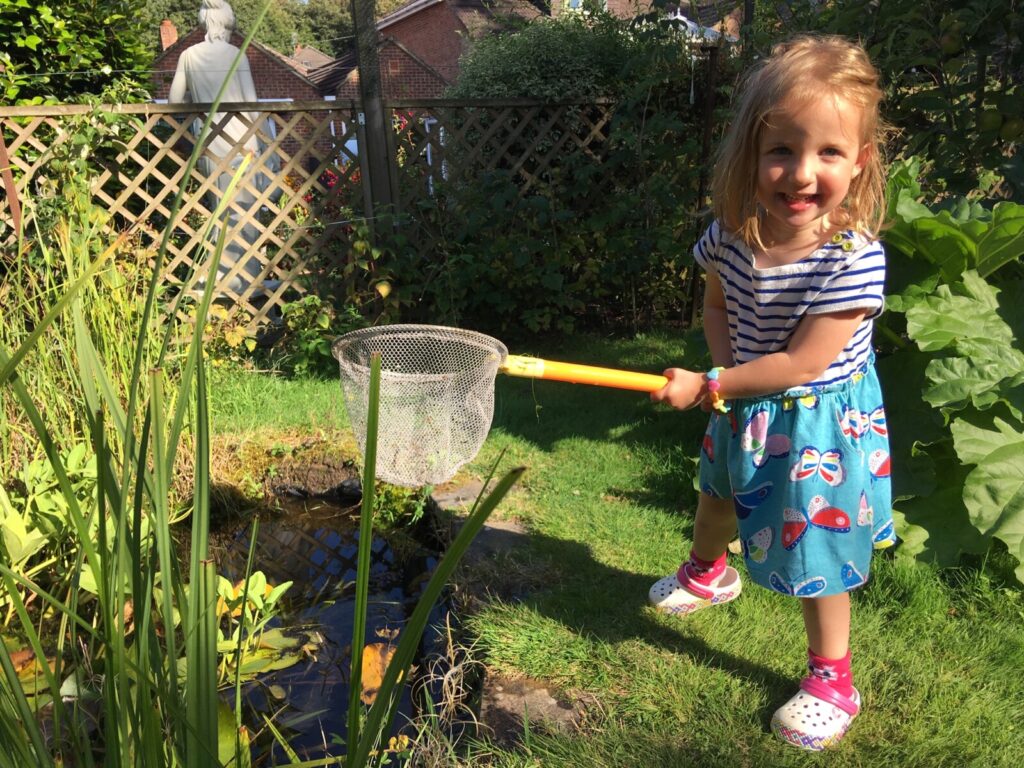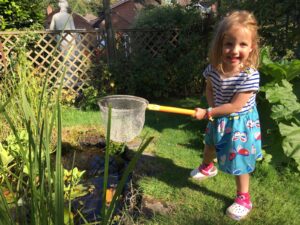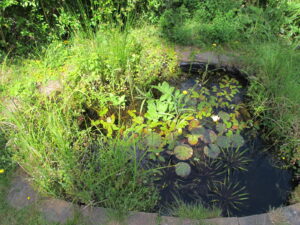
Pond Ponderings: From a Life Long Pond Fan in Berkshire
14/05/2020
Des Sussex is our newest Pond Ponderings writer, he is also our volunteer County Dragonfly Recorder for Berkshire. Enjoy this first installment from Des about his wildlife pond in Sandhurst.
“I have always loved – and been fascinated – by ponds and pondlife. This started when I was ‘little’ thanks to my Dad. He put a small pre-moulded pond in our garden and we put some frog spawn in it. As a youngster I remember thinking the adult frogs were a bit scary – perhaps due to their erratic jumping or because they were slimy. That tiny pond was under a big pear tree and inevitably filled with leaves and (….thinking back 50 years) it must have become badly stagnant. But it got me started. I was an immediate pond fan.
Start ‘em young
Since then I have made at least one garden pond at all the houses I have lived in. The ponds have kept me occupied, but have also given me a chance to introduce many of our relatives and friends children to nature up close and personal. I always keep a few nets handy for some spontaneous pond dipping with visiting children whenever I get the chance. Their faces are a delight when they see and  hold their first newt, or scary looking dragonfly nymph. Pictured right, is my granddaughter Hazel (3 ½) who spends ages fishing out all of the snails – great pond snails and ramshorn snails. At present they are her favourites and she collects as many as she can to show her Mummy (learning to count at the same time – nature can help with so many aspects of education). Close contact with nature at an early age is so important. All children over 2 years old should have their own pond dipping net. Hazel’s nursery teacher was surprised at how much Hazel ‘likes bugs and creepy crawlies’. In my humble opinion teachers and parents should be shocked and ashamed if their children don’t like bugs and creepy crawlies.
hold their first newt, or scary looking dragonfly nymph. Pictured right, is my granddaughter Hazel (3 ½) who spends ages fishing out all of the snails – great pond snails and ramshorn snails. At present they are her favourites and she collects as many as she can to show her Mummy (learning to count at the same time – nature can help with so many aspects of education). Close contact with nature at an early age is so important. All children over 2 years old should have their own pond dipping net. Hazel’s nursery teacher was surprised at how much Hazel ‘likes bugs and creepy crawlies’. In my humble opinion teachers and parents should be shocked and ashamed if their children don’t like bugs and creepy crawlies.
I have learned so much from having a garden pond. Going out after dark (at any time of year) with a torch to see what is going on is always fascinating. I discovered many years ago that ‘my’ newts will arrive back in the pond mid-winter if it has been mild and damp, I have often seen them before Christmas. I have changed my views on when ‘the best time’ for pond management is. I think vegetation clearance and de-silting are probably best done in the autumn. Clearly doing a lot of pond ‘dredging’ in winter would be disastrous for the newts if it had been mild. I actually do some pond weed clearance ‘little at a time’ through the year. When I remove weed I spread it thinly on a metal mesh over a large ‘bowl’ with water in to allow creatures to escape dropping down into the bowl. This works well (much better than just heaping it by the pond edge) and I am always amazed at how many tiny damselfly larvae there are in the weed. I like to have plenty of different pondweeds in and on the water, and the marginal sedges and flowering plants are important – water mint and purple loosestrife are great for attracting insects. I usually aim for only about 25% ‘clear water’ in the height of summer.

Water butts, water fleas and water plants.
BDS and Freshwater Habitats Trust have campaigned for clean water ponds and habitats. This is so important. I only top up my ponds with freshly collected rain water from my water butts. If you have a garden pond you must also have a water butt ! (Government should make them mandatory, but don’t get me started….).
I still get some algae and greening of the water which is not wanted. As I want to keep the water as clear as possible I use barley straw which I replace every few months, and I sometimes add a bucket of water fleas (Daphnia) taken from my local gravel pit. The water fleas help to graze the algae, and are also a valuable food source for the newts and damselfly nymphs. I do not usually buy any pond plants from garden centres. When browsing their selections I often see unwanted ‘extras’ in the pots or trays –such as Azolla or duckweeds which can be quite invasive and become a problem. So take care if you buy any pond plants – check them carefully and give them a thorough ‘clean up’ before putting them in your pond. I did get some Crassula in my pond but I have managed to get rid of it by vigilance and ruthless removal.
Brilliant wildlife, great memories.
Some of the highlights of my garden pond watching have included:
- As a dragonfly novice my pond was colonised by blue-tailed damsels. Seeing all the different colour forms at close range was wonderful – such a common species, yet so varied, delicate and beautiful. Getting to know the ‘common’ species well is very important when you are learning a new wildlife group.
- Watching the smooth and palmate newts systematically eating all my frog spawn and tadpoles, and then eating each other’s newt eggs as well. I had not realised what voracious predators they are – I do get frogs in the garden but I have so many newts that none of the frog tadpoles ever make it to emerge.
- Seeing pond bugs like water beetles and water boatmen (and newts) active under ice in the winter – best seen by torchlight after dark.
- Seeing pond skaters attacking creatures that have come to the pond for a drink – most recently a holly blue butterfly.
- Watching my first ever dragonfly emergence – southern hawker – what an incredible transformation to see in my own back yard.
- One day a neighbour asked me to come and look at the ‘alien bug’ that she had found in her ornamental fish pond. It was an emperor dragonfly exuvia. She was delighted to find out that her pond was supporting one of Britain’s biggest and most impressive insects. I didn’t let on that it had probably eaten lots of her baby fish……

I am lucky to be able to get out and about quite a lot, and if I find a pond in the countryside it is like a magnet for me. Ponds of any size or shape or depth can be full of fascinating life – as long as they have clean unpolluted water. Get yourself a pond net and go for a dip! I have been lucky that near to me some major landowners (including farmers and Forestry Commission) have created new wildlife ponds for me to explore. Many ponds are ruined for wildlife by dogs constantly churning them up. The best ponds are definitely those that are ‘hidden’ out of sight of dog walkers. It is incredible how quickly wildlife colonises a new pond.
Hopefully Covid19 restrictions will end soon and we can visit the countryside again. But in the meantime I am enjoying being locked down with my garden pond.”
